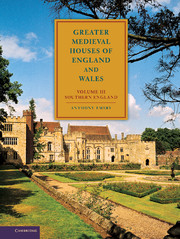Book contents
- Frontmatter
- Contents
- Acknowledgements
- List of abbreviations
- Introduction
- PART I THE THAMES VALLEY
- PART II LONDON AND SOUTH-EAST ENGLAND
- PART III SOUTH-WEST ENGLAND
- 14 South-west England: historical background
- 15 South-west England: architectural introduction
- 16 Secular art, decoration, and furnishing, 1300–1500
- 17 South-west England: bibliography
- 18 South-west England: survey
- Appendix 5 Castles of south-west England: residential additions
- Appendix 6 South-west England: residential licences to crenellate
- Appendix 7 The architectural value of John Leland and the Buck brothers
- List of plates
- List of figures
- Index
- Index of houses in volumes I, II and III
16 - Secular art, decoration, and furnishing, 1300–1500
from PART III - SOUTH-WEST ENGLAND
Published online by Cambridge University Press: 05 June 2012
- Frontmatter
- Contents
- Acknowledgements
- List of abbreviations
- Introduction
- PART I THE THAMES VALLEY
- PART II LONDON AND SOUTH-EAST ENGLAND
- PART III SOUTH-WEST ENGLAND
- 14 South-west England: historical background
- 15 South-west England: architectural introduction
- 16 Secular art, decoration, and furnishing, 1300–1500
- 17 South-west England: bibliography
- 18 South-west England: survey
- Appendix 5 Castles of south-west England: residential additions
- Appendix 6 South-west England: residential licences to crenellate
- Appendix 7 The architectural value of John Leland and the Buck brothers
- List of plates
- List of figures
- Index
- Index of houses in volumes I, II and III
Summary
THE majority of medieval houses in England and Wales are still in private hands but their interiors essentially reflect the living circumstances of the last 200 years. One or two museums or publicly owned properties have tried to reinstate a medieval character through their furnishings (Leeds Castle, Gainsborough Old Hall), but I know of only one private residence in Shropshire that has made such an attempt. Medieval secular culture has to be drawn from a broad range of sources, though in the past this was essentially limited to documentary and manuscript illustrations. More recently, it has been appreciated that some houses are able to make a major contribution to the subject, together with a range of fittings and furnishings that have survived little-known in museums and institutions.
CULTURAL CHANGES DURING THE LATER MIDDLE AGES
Culture aspires to standards of taste in the arts, humanities, and behaviour. It is a reflection of a particular time and place, but whereas it changes with considerable rapiditytoday, the time span of change during the middle ages took rather longer. At the extreme, it took over a hundred years before the first manifestations of the Italian-based Renaissance reached England. Until the time of Edward I, the centralisation of the church and the powerful cultural forces coming from Europe throughout the twelfth and thirteenth centuries meant that English culture tended to be French-based, though there was also an Italian element in the first flowering of arts in England under Henry III.
- Type
- Chapter
- Information
- Greater Medieval Houses of England and Wales, 1300–1500 , pp. 468 - 482Publisher: Cambridge University PressPrint publication year: 2006



